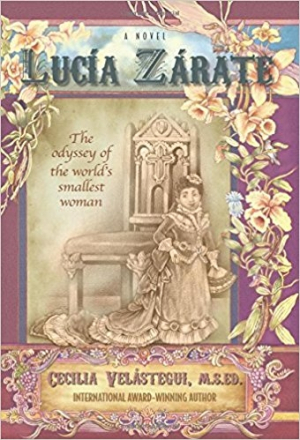Lucia Zárate
The odyssey of the world's smallest woman
- 2017 INDIES Finalist
- Finalist, Multicultural (Adult Fiction)
The sad life story of the diminutive Lucia Zárate is intriguing and informative.
Cecilia Velástegui’s historical novel, Lucia Zárate, chronicles the extraordinary life of the tiniest person who ever lived. The opening pages, lyrical and riveting, paint Mexico with vivid brushstrokes, bringing the sights, sounds, and smells of Veracruz and its vanilla bean industry to life.
Like all historical fiction, Lucia Zárate plaits fact and fancy. Lucia Zárate (January 2, 1864–January 15, 1890) holds the Guinness World Record as the smallest human, measuring twenty-one inches tall and weighing less than five pounds at seventeen years of age. Velástegui describes her as “a wisp of a girl, a perfect and miniature thing, whose singular appearance and sparkling personality were as unique as the cherished fragrance of Veracruz vanilla.” Despite her diminutive size, she “spread the velvet folds and lace frills of her gowns in such a way that she extended her personal space in a wide circle all around her.”
Incorporated into the fictitious elements are actual newspaper accounts of Lucia’s nineteenth-century tour of America and Europe. Sometimes these factual reports are artfully woven into the tale; other times, not. As a result, the book wavers between pure history and historical fiction, never landing squarely on either one.
Lucia’s story is told primarily from the vantage point of her governess, Zoila. When Zoila realizes she must extricate herself from her village’s internecine vanilla bean trade skirmishes, as well as from the rumors swirling around her own perhaps-nefarious actions, she tucks a vial of her beloved Felipe’s salvaged blood between her ample breasts and heads out. She secures a position as governess for the improbably tiny Lucia, whose parents have contracted for their daughter to perform in human curiosity sideshows. Zoila accompanies the Lilliputian girl on the decade-long tour, with visits to domestic and foreign heads of state, as well as considerable time spent among seedy denizens and gawking voyeurs.
Lucia and Zoila are well-drawn and complex figures; their emotions ebb and flow according to the particular circumstances they encounter, making them believable characters. Other individuals, however, are less fully developed; they include slimy carnival hucksters, cruel freak-show managers, and greedy parents who want to live in luxury, financed on the back of their tiny treasure of a daughter. Aside from Zoila and Lucia, not one compassionate or multifaceted individual appears in the story. Well-rounded supporting characters would have made the fictive elements more credible.
This sad life story is intriguing and informative. Velástegui’s sensitive descriptions of humans with a variety of deformities and odd conditions is commendable, as is her condemnation of their abominable treatment in nineteenth-century sideshows. Lucia Zárate should appeal to people interested in the human psyche, and those drawn to history should appreciate the author’s adherence to carefully researched historical details. Also, young adults with sophisticated vocabularies should enjoy this book.
Reviewed by
Nancy Walker
Disclosure: This article is not an endorsement, but a review. The publisher of this book provided free copies of the book and paid a small fee to have their book reviewed by a professional reviewer. Foreword Reviews and Clarion Reviews make no guarantee that the publisher will receive a positive review. Foreword Magazine, Inc. is disclosing this in accordance with the Federal Trade Commission’s 16 CFR, Part 255.

